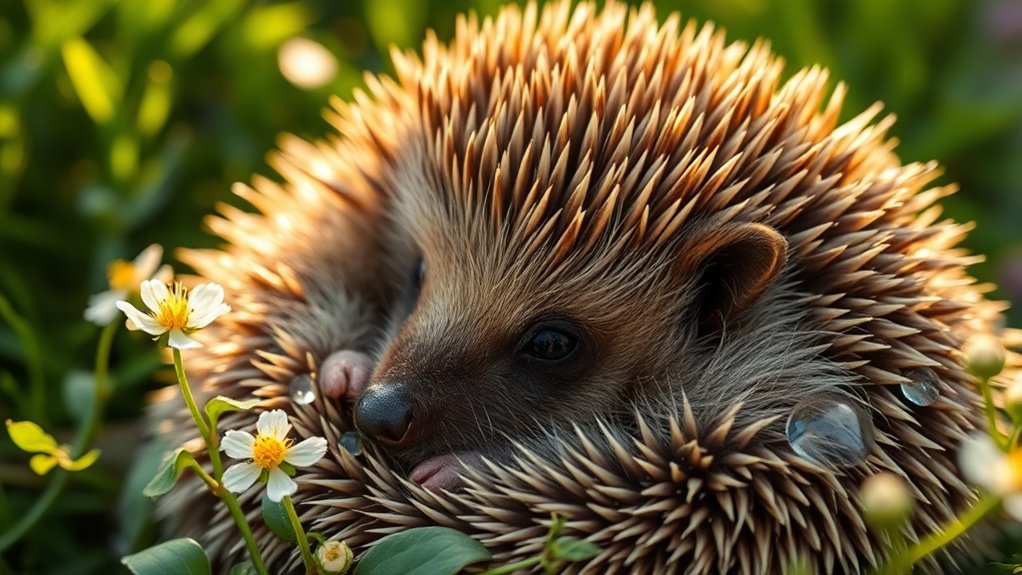Hedgehog Symbolism: Protection, Resourcefulness & Defense
Hedgehogs are known for their quills. These creatures show a unique mix of protection and resourcefulness. When threatened, they curl into a ball, demonstrating resilience. What do these traits mean for us? Exploring hedgehog symbolism can offer insights into personal growth and defense mechanisms in our lives. Understanding these qualities can help us build our own strength and protect ourselves in challenging situations.
Key Takeaways
Hedgehogs symbolize protection and serve as guardians against evil spirits in many cultures. They play a vital role in keeping communities safe.
Their quills represent self-defense and highlight the need for emotional boundaries to maintain personal well-being.
Hedgehogs show resourcefulness by curling into a ball and foraging for food. These behaviors demonstrate their resilience in nature.
In different cultures, hedgehogs are seen as symbols of good luck and fertility. They reflect the desire for safety and community strength.
Hedgehog traits can inspire personal growth. They encourage intuition, adaptability, and a protective mindset during tough times.
The Hedgehog in Folklore and Mythology
Hedgehogs may seem like small, ordinary animals, but they've an interesting presence in folklore and mythology around the world. Many stories portray hedgehogs as symbols of cleverness and strength. In these tales, hedgehogs are often seen as wise creatures, despite their size.
In ancient cultures, hedgehogs represented protection. Their ability to curl into a ball serves as a reminder of their defensive skills. Legends from Europe and Asia often depict hedgehogs as guardians against evil spirits. This shows their significance in local traditions.
These folklore stories highlight how hedgehogs create a sense of community. They remind us that even small beings can hold great value and strength.
Hedgehogs teach us about the importance of resilience and belonging.
The Meaning of Quills: A Symbol of Defense
When you see a hedgehog curl into a ball, its quills rise sharply. These spines are a strong symbol of defense. The quills help protect this small animal from danger.
When threatened, the hedgehog rolls up, using its quills as a shield against predators. This behavior shows the importance of self-defense and resilience.
You may find a connection to the hedgehog's instinct. Like the hedgehog, you can set boundaries to protect your emotional well-being.
Recognizing the symbolism of quills can help you understand and appreciate your own defense mechanisms. This understanding fosters a sense of belonging, even in a challenging environment.
Resourcefulness in Nature: How Hedgehogs Survive
Hedgehogs show how resourceful animals can be in nature. They adjust their behaviors to survive in different environments.
Here are some key ways they thrive:
- They curl into a ball to protect themselves from predators.
- They search under leaves for hidden food sources.
- They're active at night, which helps them avoid danger.
- They hibernate during cold winters to save energy.
These simple but effective strategies highlight the resilience of hedgehogs in facing challenges.
Their ability to adapt is a testament to their survival skills.
The Hedgehog as a Symbol of Protection
The hedgehog has a unique way of protecting itself. Unlike many animals that depend on size or speed, hedgehogs use physical traits and behaviors for defense. When faced with danger, they curl into a tight ball. This instinct helps them shield themselves from predators, as their spiky skin acts like armor.
Hedgehogs also show protective behavior towards their young. This instinct to defend highlights the importance of safety in communities. Watching hedgehogs in their natural surroundings can reveal how their defensive actions symbolize nurturing and care.
Lessons From Hedgehog Behavior: Embracing Vulnerability
Hedgehogs are often seen as solitary animals, but they teach us important lessons about vulnerability. When threatened, they curl into a ball. This action shows us that being vulnerable is a natural response.
While you may want to protect yourself, remember that hedgehogs also come out of their shells, adapt, and become stronger.
Here are some key insights to consider:
- Vulnerability can be a strength.
- Embracing your feelings helps build emotional resilience.
- Opening up to others creates deeper connections.
- Facing your fears can lead to personal growth.
Reflect on these lessons from hedgehogs and see how they can apply to your life. Embracing vulnerability can lead to stronger relationships and a deeper understanding of yourself.
Cultural Significance of Hedgehogs Across the Globe
Hedgehogs hold significant cultural meaning in many societies. They often symbolize protection and resourcefulness. Traditions about hedgehogs differ across cultures, but they share a common belief: hedgehogs can ward off danger.
In Europe, people view hedgehogs as symbols of good luck and fertility. In some African cultures, hedgehogs connect to the spirit world. These beliefs highlight hedgehogs as guardians, showing that true strength can come from being vulnerable.
Understanding these views helps us appreciate the hedgehog's importance. They represent our desire for safety and resilience.
The Hedgehog's Role in Ecosystems: A Reflection of Balance
Hedgehogs play a vital role in ecosystems. They live in various habitats, including gardens and woodlands. These small animals help keep insect populations in check, which is essential for healthy gardens and crops.
Here are key ways hedgehogs contribute to the ecosystem:
- Natural pest control: They reduce insect numbers, benefiting plants.
- Soil aeration: Their foraging activities help improve soil quality.
- Food source: They serve as prey for larger animals, supporting the food chain.
- Biodiversity: They add to the variety of life in their environment.
Hedgehogs remind us of the importance of balance in nature. Appreciating their role encourages us to protect and support our ecosystems.
Spiritual Symbolism: What Hedgehogs Represent
Hedgehogs play a key role in nature and hold significant spiritual meanings in different cultures. They symbolize protection and defense, emphasizing self-preservation.
When hedgehogs curl into a ball, they display resilience, reminding us to protect ourselves during tough times. Their intuition invites us to trust our instincts in challenging situations.
Embracing these qualities can help us feel connected, showing that we aren't alone in our difficulties. Overall, hedgehogs represent the journey of facing life's challenges with strength and grace.
Personal Growth Through Hedgehog Traits
Life presents challenges. Embracing hedgehog traits can improve your personal growth. These traits help you build resilience and protect your emotions.
Here are key hedgehog traits to consider:
- Trust your intuition to make decisions.
- Use self-discovery methods to understand yourself.
- Grow and adapt when facing difficulties.
- Maintain a protective mindset for emotional safety.
By integrating these traits into your life, you turn challenges into chances for understanding and connection.
The wisdom of the hedgehog can lead you on a meaningful journey of self-exploration and belonging.
Embracing Your Inner Hedgehog: Practical Applications for Life
Embracing your inner hedgehog can change how you handle life's challenges. By practicing mindfulness, you become aware of your surroundings and your feelings. This awareness helps you respond to difficulties calmly.
When you face obstacles, think creatively like a hedgehog. Use your resourcefulness to find new solutions. This mindset helps you connect more deeply with yourself and others.
Additionally, embracing your creativity allows you to express your unique self. This expression leads to genuine relationships.
Remember, it's about thriving, not just surviving. By adopting these traits, you can turn life's tough moments into opportunities for growth and connection.
Enjoy the journey of discovering your inner hedgehog!
Frequently Asked Questions
What Are Common Myths About Hedgehogs That Aren't True?
Hedgehogs do not roll into balls for defense; they use their quills instead. Another common myth is that hedgehogs drink milk. In reality, milk can harm them. Understanding these facts helps you appreciate hedgehogs better!
How Do Hedgehogs Communicate With Each Other?
Hedgehogs communicate using sounds and scents. They make distinct vocalizations during social interactions. These sounds help them express their feelings and needs. Additionally, hedgehogs use scent marking to establish their territory. This behavior is important for their social structure. By observing these actions, we can understand their community dynamics better. Hedgehogs rely on both vocal and scent cues to interact and connect with each other.
What Are the Different Species of Hedgehogs?
There are several species of hedgehogs. The African Pygmy hedgehog is small and popular as a pet. The European Hedgehog is commonly seen in gardens. The Asian Hedgehog lives in various habitats across Asia. The Long-eared Hedgehog is unique due to its large ears. Each species has distinct traits and environments.
Can Hedgehogs Be Kept as Pets Legally?
Before getting a hedgehog as a pet, check your local laws. Pet ownership rules differ by state. Some areas may have restrictions or require permits for hedgehogs. Make sure to follow these regulations to ensure responsible pet ownership.
What Do Hedgehogs Eat in the Wild?
In the wild, hedgehogs eat insects, worms, and small fruits. Their diet is diverse and helps them adapt to different environments. Hedgehogs are resourceful foragers, showing how they can find food even with challenges around them. This ability to seek out various food sources is key to their survival.

Hi, I’m Ethan—a spiritual wordsmith at SpiritualDivineInsight.com. My passion lies in exploring the mysteries of spirituality and sharing transformative insights. Through my articles, I invite you on a journey of self-discovery and mindfulness. Join me as we navigate the path to enlightenment together.







